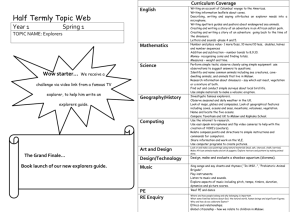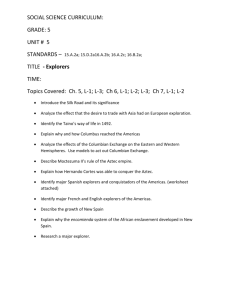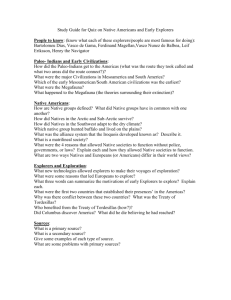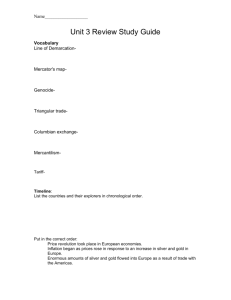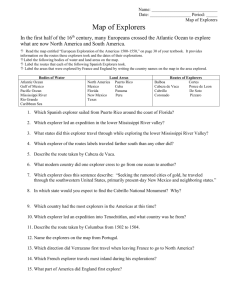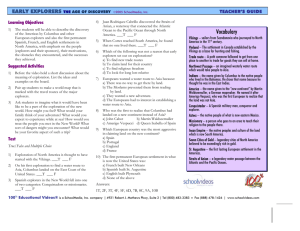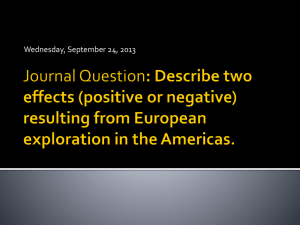Explorers Grade Five Social Studies Strands
advertisement
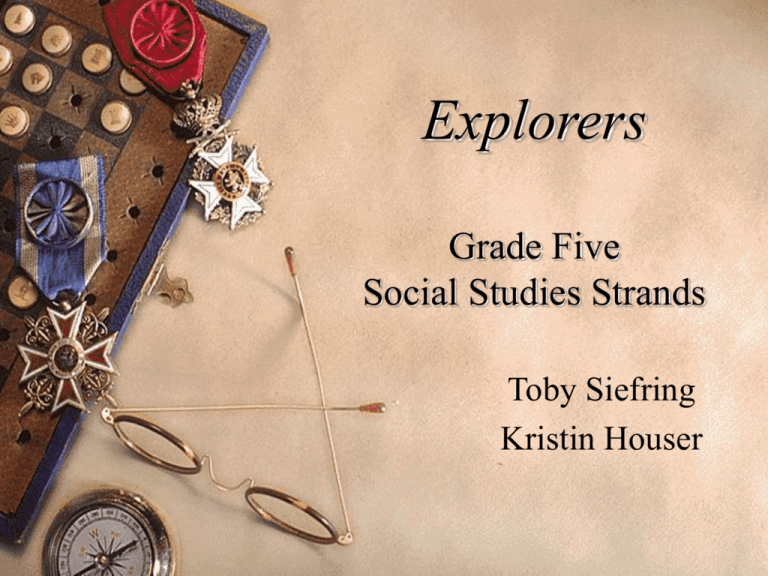
Explorers Grade Five Social Studies Strands Toby Siefring Kristin Houser Table of Contents 1. 2. 3. 4. 5. 6. 7. 8. History…………………………………….3 People in Societies………………………...8 Geography………………………………..13 Economics………………………………..18 Government………………………………23 Citizenship Rights and Responsibilities….29 Social Studies Skills and Methods……….34 Science Technology and Society………...39 Strand One: History Activities for History • The students will create a time line of Christopher Columbus’s voyages to the New World. This will be done on adding machine paper so every student may create their own timeline. • The students will be assigned one explorer of the New World to research. They will give a short (5 – 10 minute) speech presenting themselves as that explorer. Costumes will earn extra credit. Activities Continued… • Students will play the game “Go West with Columbus” which can be found at the following site: http://www.brybackmanor.org/actpag10.html • Students are to find one lasting effect that an explorer left in the New World (i.e. language, food, etc.). They will create a poster board of this lasting effect to display in the hallway. • Students will build a Viking ship using clay. They must find a picture of a Viking ship to model their design after. A brief explanation of the ship should accompany the clay model. Websites for History • Explorers: http://www.mce.k12tn.net/explorers/explorers_start.ht m This website gives a list of activities to use with units on Explorers. • Columbus Navigation: http://www1.minn.net/%7Ekeithp/ This website gives a timeline of Columbus’s voyages and his life. • Christopher Columbus: http://www.win.tue.nl/cs/fm/engels/discovery/columb us.html This website is for navigators and their accomplishments in the New World. It contains a lot of useful facts for research. Websites Continued… • Enchanted Learning: http://www.enchantedlearning.com/explorers/page/c/c olumbus.shtml Enchanted learning makes learning about explorers fun for students. It also gives some great ideas for activities for educators and parents. • Surfing the Net with Kids: http://www.surfnetkids.com/columbus.htm This website gives unknown facts about Columbus and other explorers. It is full of interesting information that students would find funny. Strand Two: People in Societies Activities for People in Societies • Students will compare the clothing worn by 15th Century people in Europe with that of clothing that is worn today. They will write a short paper describing their findings. • Students will research how the expeditions to the New World began. They will write, as a class, a short play about King Ferdinand and Queen Isabella. • Students will compare the reasons for immigration to the New World between Africa, Spain, Europe, etc. Activities Continued… • Students will research an explorer from the 20th Century and compare it to one of the 15th Century. Focusing on their clothing, language, and missions. A paper will be collected for this activity. • Students will prepare a Spanish festival for class, including 15th Century food, clothing, music, art, etc. Websites for People in Societies • Enchanted Learning: http://www.enchantedlearning.com/Dictionary.html Enchanted Learning gives a list of facts about many explorers past and present. • Explorers: http://edtech.kennesaw.edu/web/explorer.html This website has a list of hundreds of explores through time. It included facts, pictures, and comparisons. • Explorers’ Club: http://www.explorers.org/ This is a club for students to join that are interested in explorations. Websites Continued… • http://www.cdli.ca/CITE/explorer.htm This website gives information on the many European Explorers through the years. It gives maps, pictures, and facts. • http://web54.sd54.k12.il.us/schools/hale/pgraf/e xplorers99/sld001.htm This page is a PowerPoint presentation designed by students about many explorers that they research. Strand Three: Geography Activities for Geography • Students will choose an explorer and map their expedition on a piece of poster board. They must draw map and then place the route on the map. • Students will compare and contrast the physical features of Europe to that of North America. • Students will create a location for a new land for them to explore. They must include latitude/longitude, physical features, and inhabitants. Activities Continued… • Students will construct a mapping of the colonization of North America by the Europeans. The map will be provided to the students, and they may creatively develop a representation of the colonization. • Student will analyze the positive and negative consequences of human changes to the New World. One group will be responsible for the positives and the other group the negative. Students will then use the class time for a whole class debate. Websites for Geography • Education Planet: http://www.educationplanet.com/articles/explore rs.html This website links geography with the explorations of 15th Century. • Social Studies School Service: http://www.socialstudies.com This website will teach the students about paths of explorations and maps of the conquering. Websites Continued… • Explores: http://zephyr.esd123.org/htbin/wwform/www/?TEXT= R1727326-1746902/www/documents/079/cat/idx770.htm This website gives specific information of the path of exploration for several explorers. • National Geographic: http://www.nationalgeographic.com/ This website is full of pictures for students to view. It contains a lot of facts as well. • Geography: http://www.eduex.com/Geography/ This website focuses on geography of the world. It has parts that discuss explorations through time. Strand Four Economics Activities for Economics • Students will find what Spanish money looked like in 1400 by research on the Internet. They will then compare and contrast their money to ours today. • Students will research what goods were important to the European explorers. Then they will research if those good were available to them in the New World. Activities Continued… • Students will create a poster board with their answer to “Why do countries explore?” They are to use facts, opinions, and lots of pictures. • Students are to create their own money for use in the New World. What would they have designed our money to look like? • Students are to answer the following question in a short essay: What did Indians in the New World produce, how did they produce it, and for whom did they produce it for? Websites for Economics • The Federal Reserve Bank: http://www.ny.frb.org/education/econexjrnl.pdf This site discusses the change in currency from past to present. It gives pictures of several types of currency. • Economics for Kids: http://www.kathimitchell.com/econ.htm This site helps kids to understand economics, and it relates economics to the discoveries of new land. Websites Continued… • Early Explorers: http://www.coreknowledge.org/CKproto2/resrcs/lesso ns/199explorer.pdf This page discusses early explorers and they survival techniques in a new land. • Kid Info: http://www.kidinfo.com/American_History/Explorers. html This page gives short research information on explorers. It also discusses money, Indian survival techniques, and goods and services of European lands. • The European Voyages: http://www.ucalgary.ca/applied_history/tutor/eurvoya/ This page is for reference about how Europe influenced the world through their explorations. Strand Five Government Activities for Government • Students will compare and contrast the governments of 15th century England to the U.S. government of today in a short paper. Resources will be available in the classroom for research, and they may work in pairs. • Students will research and report on how the U.S. Government affected the age of American continental exploration in the 19th century. They should be sure to discuss the great surveyors in this time in a 2-3 page paper. Activities continued… • Each student should choose an American explorer of their choice, and prepare a short presentation on how their actions influenced American democracy. • The class will be set up to reenact the debate before the explorers Lewis and Clark’s expedition. One student will be President Jefferson, a group will act as the Congress approving the trip, two as the explorers with the rest of the class being the people to travel with Lewis and Clark. After the reenactment each student will turn in a short summary of the event. Activities continued • Students will be put into small groups to search the Internet for information on the style of government followed by the Native Americans. They will then give a short presentation to the class (in any creative manner they wish). Websites for Government • Discoverers and Explorers: http://www.isu.edu/~trinmich/Discoverers.html This site offers facts and figures regarding the Oregon Trail. It goes into detail on the exploration across the trail and offers quicklinks for quicker access. • Westward Explorers: http://www.nps.gov/jeff/LewisClark2/Circa1804/ WestwardExpansion/EarlyExplorers/OtherExplore rs.htm This site discusses the Governments affect on the Big-Four Surveys in the age of American exploration. It offers timelines as well as detailed explanations. Websites continued… • Explorers, Frontiersman, Pioneers, Frontiersmen, Trappers: http://www.linecamp.com/museums/americanwest/hu bs/pioneers_explorers_frontiersmen/pioneers_explorer s_frontiersmen.html This site offers many links and a lot of information from the days of the Wild West. • Explorers of the Millennium: http://library.thinkquest.org/4034/ This website focuses on 19 of the most popular explorers over the last 1000 years. There are timelines, facts, quizzes, and much more. • American Explorers: http://www.enchantedlearning.com/explorers/nameric a.shtml This site alphabetically lists American explorers with brief information and a link for more. Strand Six • Citizenship Activities for Citizenship • Students will choose a country and find the citizen’s rights within that country in the 17th century and present their information to the class. • Students will choose any explorer and create a passport (as you would find one today) for that explorer to be admitted into a different country. • The students will turn their classroom into a foreign country in the past. The class will investigate what it takes to become a natural citizen and obey laws and such of that country for a day. Activities continued… • Students will choose a particular freedom of our nation and compare that freedom to the the Native Americans in the 16th and/or 17th centuries. They will turn in a written paper with their findings. • Students will create a timeline of a typical day of an explorer of their choice. They will then create a timeline of their personal typical day and compare the two. Creativeness through drawings and pictures is encouraged. Websites for Citizenship • Native American Conquest: http://www.estudent.net/ This is a high-tech website with audio and visual displays offering a lot of information about the 1st Americans. • European Explorers: http://www.cdli.ca/CITE/explorer.htm This site offers links to many European Explorers and categorizes them by country. • Age of Exploration Timeline: http://www.mariner.org//educationalad/ageofex/ti meline.php This is an extensive, detailed timeline throughout the history of exploration. Websites Continued… • South American Explorers: http://www.win.tue.nl/~engels/discovery/southam. html This site focuses on explorers, such as the Conquistadors, of South America. • Vikings: http://www.mariner.org//educationalad/ageofex/vi king_disc.php This site is devoted to the discoveries of the Vikings, and the Viking explorers who contributed to these discoveries. Strand Seven • Social Studies Skills and Methods Activities for Skills and Methods • Each student will conduct themselves as a newspaper journalist reporting on one of the voyages of Christopher Columbus. They may use any sources to gain information. The final newspapers will be hung in the hallway. • Students will pull names of explorers from a hat and compile information (facts, pictures, etc.) into a portfolio pertaining to their particular explorer. • Students will find a book about any interesting explorer they would like. Students will be given time in class and be responsible for reading outside of class. After completing the book, each child will do a book report. Activities continued… • Students will be paired up and assigned a specific period of American exploration. They are to create a timeline or graph of all the major exploration events in that time. • Students will find information from three different sources about one explorer of their choice. They will critique the source of information and rank the source on a scale of their making or finding. Websites for Skills and Methods • Christopher Columbus: http://www.mariner.org//educationalad/ageofex/colu mbus.php This site is devoted to Columbus and has links to the four voyages in his exploration. • Explorers’ Themes Page: http://www.cln.org/themes/explorers.html There are numerous links from this page pertaining to specific themes of exploration. There are annotations of each link. • Example Report: http://www.cdli.ca/CITE/amexp.htm This site allows students to view a sample report done by a 5th grade student on the explorer John Cabot. Websites continued… • Explorers: http://www.mce.k12tn.net/explorers/explorers_star t.htm This site has different categories for reviewing the explorers. It also offers activities and quizzes about each category. • Spanish Empire: http://www.wsu.edu:8080/~dee/REFORM/EMPIR E.HTM This site explains how the Native Americans did not last in the Spanish Empire and leads into the Northern Renaissance. Strand Eight • Technology Activities for Technology • Students will be able to work in small groups and put together a PowerPoint presentation about any explorer. The PowerPoint should be at least 10 slides. • Students will be given a list of movies in some regards to explorers. The students will be able to vote which movie they would like to watch in class. Students will be given a short quiz over the movie they select. Activities continued… • Students will be taken on a field trip to Sunwatch to explore for themselves how the Native Americans lived. They will write a one-page typed response on their trip. • Students will create their own compass with materials given in class (styrofoam, paperclip, magnet, bowl of water, marker). They will then write a journal entry how a compass helped explorers on their journey. Activities continued… • Students will work in pairs to design their own video game. The game will be relative to the lifestyle of an explorer or a particular group of explorers. Each group will have the opportunity to share the game they design. Websites for Technology • Evolution of Steering Ships: http://www.mariner.org//educationalad/ageofex/ste ering.php This site reviews the evolution of these ships over the course of the world’s history. • Henry the Navigator: http://www.win.tue.nl/cs/fm/engels/discovery/henr y.html This website investigates the life of Henry the Navigator and also the technology and techniques he used in his lifetime. Websites continued… • Explorers: http://www.kathimitchell.com/explorer.htm This website has endless links to specific and general explorer information. • European Explorers: http://www.chenowith.k12.or.us/tech/subject/socia l/explore.html This site offers excellent links about many explorers. • Who Really Discovered America, eh?: http://www.lawzone.com/half-nor/swearinger.htm This site allows you to view a speech by a California judge on his thoughts of who really discovered America. Explorers Grade 5 THE END
